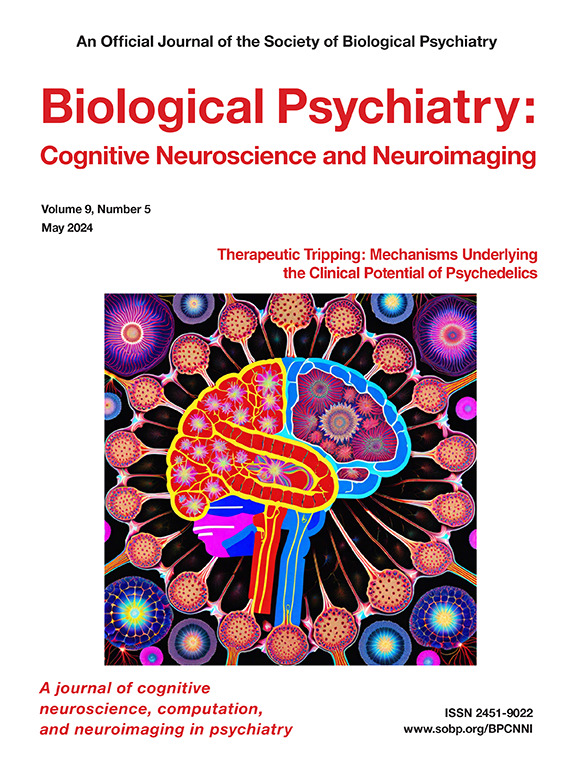Leveraging Distributed Brain Signal at Rest to Predict Internalizing Symptoms in Youth: Deriving a Polyneuro Risk Score From the ABCD Study Cohort
IF 5.7
2区 医学
Q1 NEUROSCIENCES
Biological Psychiatry-Cognitive Neuroscience and Neuroimaging
Pub Date : 2025-01-01
DOI:10.1016/j.bpsc.2024.07.026
引用次数: 0
Abstract
Background
The prevalence of internalizing psychopathology rises precipitously from early to mid-adolescence, yet the underlying neural phenotypes that give rise to depression and anxiety during this developmental period remain unclear.
Methods
Youths from the Adolescent Brain Cognitive Development (ABCD) Study (ages 9–10 years at baseline) with a resting-state functional magnetic resonance imaging scan and mental health data were eligible for inclusion. Internalizing subscale scores from the Brief Problem Monitor-Youth Form were combined across 2 years of follow-up to generate a cumulative measure of internalizing symptoms. The total sample (N = 6521) was split into a large discovery dataset and a smaller validation dataset. Brain-behavior associations of resting-state functional connectivity with internalizing symptoms were estimated in the discovery dataset. The weighted contributions of each functional connection were aggregated using multivariate statistics to generate a polyneuro risk score (PNRS). The predictive power of the PNRS was evaluated in the validation dataset.
Results
The PNRS explained 10.73% of the observed variance in internalizing symptom scores in the validation dataset. Model performance peaked when the top 2% functional connections identified in the discovery dataset (ranked by absolute β weight) were retained. The resting-state functional connectivity networks that were implicated most prominently were the default mode, dorsal attention, and cingulo-parietal networks. These findings were significant (p < 1 × 10−6) as accounted for by permutation testing (n = 7000).
Conclusions
These results suggest that the neural phenotype associated with internalizing symptoms during adolescence is functionally distributed. The PNRS approach is a novel method for capturing relationships between resting-state functional connectivity and behavior.
利用静息状态下的分布式大脑信号预测青少年的内化症状。
背景:从青春期早期到中期,内化性精神病理学的发病率急剧上升,但在这一发育阶段导致抑郁和焦虑的潜在神经表型仍不清楚:方法:青少年大脑和认知发展研究(Adolescent Brain and Cognitive DevelopmentSM Study)中的青少年(基线年龄为 9-10 岁)均符合纳入条件,他们均有静息态 fMRI 扫描和心理健康数据。在两年的随访过程中,将 "简明问题监测--青少年表 "中的内化子量表得分进行合并,得出内化症状的累积测量值。总样本(n = 6521)被分成一个大的发现数据集和一个较小的验证数据集。发现数据集估算了静息态功能连接(RSFC)与内化症状的大脑行为关联。每个功能连接的加权贡献通过多变量统计进行汇总,生成多神经风险评分(PNRS)。在验证数据集中评估了多神经风险评分的预测能力:PNRS解释了验证数据集中观察到的内化症状评分变异的10.73%。当保留发现数据集中确定的前 2% 的功能连接(按绝对 β 权重排序)时,模型性能达到峰值。最突出的 RSFC 网络是默认模式网络、背侧注意网络和顶叶鞘网络。这些发现在排列组合测试(n = 7000)中具有显著性(p < 1*10-6):这些结果表明,与青春期内化症状相关的神经表型具有功能分布性。PNRS方法是一种捕捉RSFC与行为之间关系的新方法。
本文章由计算机程序翻译,如有差异,请以英文原文为准。
求助全文
约1分钟内获得全文
求助全文
来源期刊

Biological Psychiatry-Cognitive Neuroscience and Neuroimaging
Neuroscience-Biological Psychiatry
CiteScore
10.40
自引率
1.70%
发文量
247
审稿时长
30 days
期刊介绍:
Biological Psychiatry: Cognitive Neuroscience and Neuroimaging is an official journal of the Society for Biological Psychiatry, whose purpose is to promote excellence in scientific research and education in fields that investigate the nature, causes, mechanisms, and treatments of disorders of thought, emotion, or behavior. In accord with this mission, this peer-reviewed, rapid-publication, international journal focuses on studies using the tools and constructs of cognitive neuroscience, including the full range of non-invasive neuroimaging and human extra- and intracranial physiological recording methodologies. It publishes both basic and clinical studies, including those that incorporate genetic data, pharmacological challenges, and computational modeling approaches. The journal publishes novel results of original research which represent an important new lead or significant impact on the field. Reviews and commentaries that focus on topics of current research and interest are also encouraged.
 求助内容:
求助内容: 应助结果提醒方式:
应助结果提醒方式:


